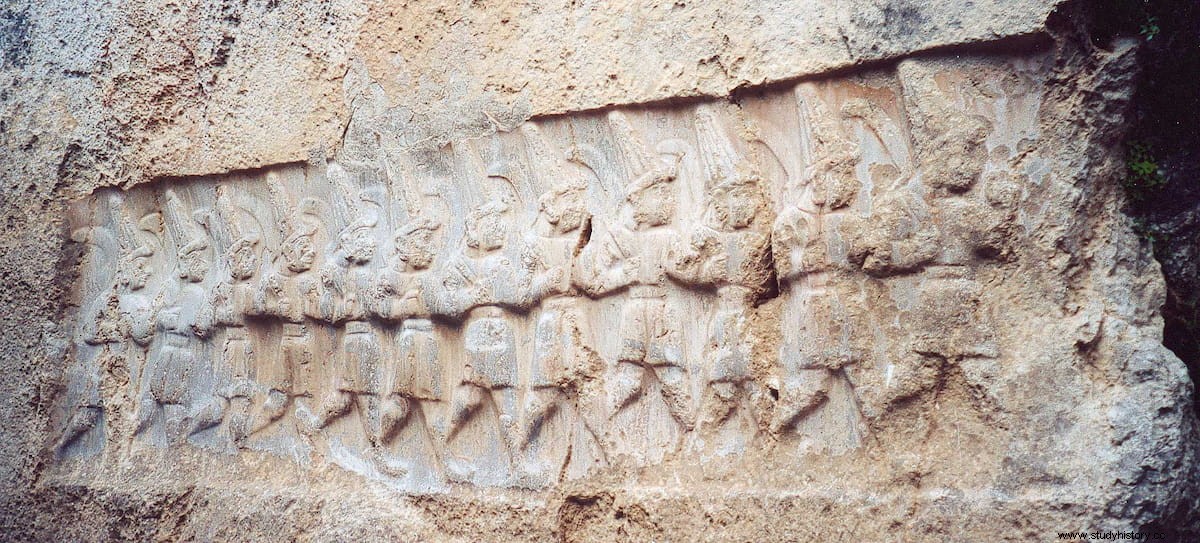For nearly two hundred years, archaeologists have searched for a plausible explanation for the ancient Yazılıkaya rock sanctuary in central Turkey. More than 3,200 years ago, stonemasons carved more than 90 reliefs of deities, animals, and chimeras into the limestone bedrock.
An international team of researchers now presents an interpretation that for the first time suggests a consistent context for all the figures. Thus, the reliefs carved in stone in two rock chambers symbolize the cosmos:the underworld, the earth and the sky, as well as the recurring cycles of the seasons, the phases of the moon and day and night.
The Yazılıkaya rock sanctuary is a UNESCO cultural heritage site, and yet it is also one of the great puzzles of archaeology. The sanctuary is located in central Turkey, about 150 kilometers east of Ankara, near the ancient Hittite capital Hattuša. In the 13th century BC, more than ninety figures, mostly divinities, were carved into the stone of two natural rock chambers, and a temple was erected in front of them. Scientists today agree that the shrine was an important place of worship at the time of the Hittite kingdom (c. 1650-1190 BC).

The reliefs of the Hittite gods follow a strict hierarchical order and face an image of the great King Tudhalija IV. However, the meaning of the procession has been a mystery since scholars first saw it nearly two hundred years ago. Prehistorian Juergen Seeher, who led the excavations at Hattuša from 1994 to 2005, wrote in 2011 in the latest monograph on Yazılıkaya:It is still not at all clear today what function the cave sanctuary actually fulfilled .
Now, for the first time, a team of Swiss, American and Turkish archaeologists and astronomers present an explanation that encompasses all the figures in the installation and assigns each of them a plausible function. The scientific article has been published in the Journal of Skyscape Archeology , peer-reviewed, and is freely accessible. According to scientists, the sanctuary is essentially a symbolic representation of the cosmic order as the Hittites imagined it. The artistic reliefs represent, on the one hand, the static levels of the cosmos - the underworld, the earth, the sky and the most important deities on high - and, on the other, also the cyclical processes of renewal and rebirth:day and night. night, the phases of the moon and the seasons. Each of the more than ninety figures adheres to this system.

This explanation, which is obvious in retrospect, was the result of several years of intensive research. In the course of this research, geoarchaeologist Eberhard Zangger, president of the Zurich Foundation for Luwite Studies, and Rita Gautschy, archaeologist and astronomer at the Institute of Archeology at the University of Basel, realized that many of the Yazılıkaya figures indicate the lunar phases and the time of the solar year.
The researchers published this interpretation in 2019 in a scientific article. Later research focused on the symbolic significance of the shrine as a whole; In addition to Zangger and Gautschy, E. C. Krupp, director of the Griffith Observatory in Los Angeles, and Serkan Demirel, historian of antiquity at the Technical University of Karadeniz (Turkey), participated in it.
The new interpretation integrates many components that scientists had previously recognized. This applies to the function of a lunisolar calendar, but also to the meaning of Chamber B as a symbol of the underworld, which is indicated, among other things, by a relief of the god Nergal. However, the idea of associating the most important gods of the Hittite pantheon with the circumpolar region of the northern sky is entirely new. Constellations close to the celestial axis, visible throughout the year, play a special role in the cosmology and religion of many early cultures. In Yazılıkaya it is, among other things, his position in the procession - facing north and above the other gods - that suggests such an interpretation.

The researchers write:Thus, it seems more likely that it was a place where astronomical information was exposed so that the sanctuary as a whole cosmologically conformed to the full expression of cosmic order. The two main chambers of the sanctuary were, above all, ritual spaces that were used as a stage for an important ceremonial activity in which a specific public participated. The gods were elaborately illustrated on a large scale. This is a staging, not a mere computation.
